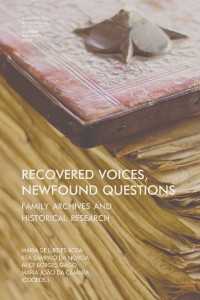Please use this identifier to cite or link to this item:
https://hdl.handle.net/10316.2/47879| DC Field | Value | Language |
|---|---|---|
| dc.contributor.author | Sottomayor-Pizaro, J. A. de | |
| dc.date.accessioned | 2020-02-17T12:40:23Z | |
| dc.date.accessioned | 2020-08-27T16:44:28Z | - |
| dc.date.available | 2020-02-17T12:40:23Z | |
| dc.date.available | 2020-08-27T16:44:28Z | - |
| dc.date.issued | 2019 | - |
| dc.identifier.isbn | 978-989-26-1794-7 (PDF) | |
| dc.identifier.isbn | 978-989-26-1793-0 | |
| dc.identifier.uri | https://hdl.handle.net/10316.2/47879 | - |
| dc.description.abstract | For the Middle Ages, before the constitution of private archives of manor houses — which occurs, for the most important part, during the fifteenth century — researchers of family history have to resort, in addition to the royal funds, mainly to monastics funds. It was in these that the diplomas concerning the members of the founding or protective families of the different monasteries were kept. I intend, therefore, through the analysis of a few examples, to highlight the importance of some document types, such as wills or letters of partition, not only to collect information about the individuals concerned, but also to record the transmission of several assets throughout the generations. | eng |
| dc.description.abstract | Para a Idade Média, e antes da constituição dos arquivos privados das casas senhoriais, o que ocorre, para as mais importantes, no decurso do século XV, os investigadores da história familiar, para além dos fundos régios, têm que recorrer sobretudo aos fundos monásticos, pois era nestes que se recolhiam os diplomas que respeitavam aos membros das famílias fundadoras ou protectoras dos diferentes cenóbios. Pretendese, assim, através de alguns exemplos, chamar a atenção para a importância de algumas tipologias documentais, como testamentos ou cartas de partilhas, não só para se recolher informação para os indivíduos em causa, mas também para poder historiar a transmissão de vários bens ao longo das gerações. | por |
| dc.language.iso | eng | - |
| dc.publisher | Imprensa da Universidade de Coimbra | por |
| dc.rights | open access | - |
| dc.subject | Middle Ages | eng |
| dc.subject | monastic archives | eng |
| dc.subject | document types | eng |
| dc.subject | family assets transmission | eng |
| dc.subject | Idade Média | por |
| dc.subject | arquivos monásticos | por |
| dc.subject | tipologias documentais | por |
| dc.subject | transmissão de bens familiares | por |
| dc.title | “E mostrarom duas arcas hua vaçia e na outra andavam cartas”: monastic fonds as family archives in the Middle Ages | por |
| dc.type | bookPart | por |
| uc.publication.firstPage | 23 | - |
| uc.publication.lastPage | 34 | - |
| uc.publication.location | Coimbra | por |
| dc.identifier.doi | h10.14195/978-989-26-1794-7_1 | - |
| uc.publication.section | Recovering, reconstructing and (re)discovering family and personal archives | por |
| uc.publication.digCollection | PB | por |
| uc.publication.orderno | 2 | - |
| uc.publication.area | Artes e humandidades | por |
| uc.publication.bookTitle | Recovered voices, newfound questions: family archives and historical research | - |
| uc.publication.manifest | https://dl.uc.pt/json/iiif/10316.2/47879/198140/manifest?manifest=/json/iiif/10316.2/47879/198140/manifest | - |
| uc.publication.thumbnail | https://dl.uc.pt/retrieve/10964825 | - |
| uc.publication.parentItemId | 56749 | - |
| uc.itemId | 67620 | - |
| item.grantfulltext | open | - |
| item.fulltext | With Fulltext | - |
| Appears in Collections: | Recovered voices, newfound questions: family archives and historical research | |
Files in This Item:
| File | Description | Size | Format | |
|---|---|---|---|---|
| e_mostrarom_duas_arcas_hua_vacia.pdf | 741.05 kB | Adobe PDF |  |
Items in DSpace are protected by copyright, with all rights reserved, unless otherwise indicated.
